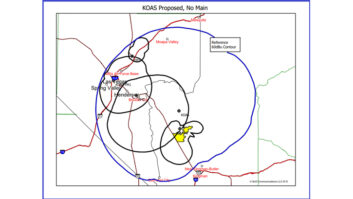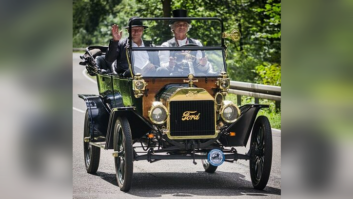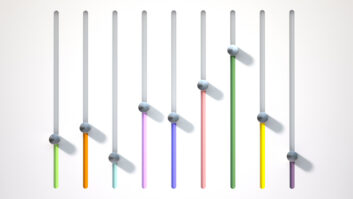Clear Transmission
Jul 1, 2005 12:00 PM, By Doug Irwin
There are several trends in broadcast transmitter technology. The most easily recognizable one is the simplification of HD Radio transmission by the introduction of more linear amplifiers (thus allowing the transmission of the analog FM signal plus the IBOC signal through the same path). A second trend is the reduction in size of standard analog solid-state transmitters, along with more use of embedded bi-directional communications links, frequency-agility, and built-in stereo generation and even audio processing.
When I first wrote about IBOC transmission in Radio magazine in August 2002, the three methods of IBOC transmission were discussed, although only one (high-level combining) was practical at that point. Although I don’t have numbers to back it up, I believe it is likely that the majority of the early adopters of HD Radio used this method.

What’s old is new. Other tube transmitters have been used to pass the IBOC signal, but Continental has released the 816HD as a regular line product.
Two things have happened in the meantime. First, the FCC has given its blessing on the use of a separate antenna for IBOC transmission (as long as certain parameters are met); and second, high-power amplifiers that can generate high TPO levels with the analog FM carrier and the IBOC carriers are now (almost) commonplace.
Let’s take for example an FM station that has a six-bay (full-wave spaced) antenna and an ERP of 50kW. Neglecting transmission line losses, this station would need about 16.7kW of power reaching the input of the antenna. In the early days of IBOC transmission, this station could have converted to IBOC transmission by installing a high-level combiner � adding 10 percent to the TPO (to make up for losses through the analog path in the -10dB combiner) � and installing an IBOC transmitter capable of putting out 1,670W to the �digital� input of the -10dB coupler (once again neglecting transmission line losses for simplification). This is not an inexpensive proposition by any means, and potentially could have necessitated the installation of a new, larger analog transmitter, a larger power feed, extra air-conditioning and more floor space.
Within the last year, Harris developed an IBOC technology that it calls split-level combining, which is a more efficient variation on the original high-level combining method. A sample of the RF from the analog exciter is added to the IBOC signals and thereafter amplified with a linear amplifier. The output of this IBOC + analog transmitter is then added through a selectable ratio combiner with the analog RF from the legacy analog transmitter. A phasing adjustment allows the user to match the phase of the carrier from the linear transmitter with that of the legacy transmitter. This method actually reduces the amount of RF needed from the analog transmitter, and couples more of the IBOC signal in to the antenna and not a waste load.
More options
While the high-level or split-level methods work for the station used in this example, the FCC has now made it easier to implement IBOC by use of a separate antenna. If this same station located another antenna on the same tower (at more than 70 percent of the HAAT) or perhaps already had a backup antenna in place, then the implementation of IBOC could be as simple as this: divide the station’s analog ERP by the second antenna’s gain; divide that by 100 (because the sum total of the upper and lower sideband groups is -20dB below the analog carrier level) and then size the IBOC transmitter accordingly. In this example the station would need 167W of IBOC power reaching the antenna input (antenna gain = 3). If an auxiliary antenna already existed, then the amount of capital needed to implement the project is reduced substantially.
If the station in this example used any sort of a combined antenna, then another possibility exists. The IBOC signals (for multiple stations) could be introduced into the antenna system by way of back-feeding the combiner, and thereafter routing the combined IBOC signals into the antenna by means of new ports built in to the hybrids at the antenna bay inputs. This also greatly reduces the TPO necessary from the IBOC transmitter.
ERI, Shively and Jampro provide interleaved antenna systems that have ports added for the introduction of the IBOC power. This is yet another way to get around the original high-level combining method.
But wait: there’s more. Continental Electronics has modified its legacy designs (class-C vacuum tube) to linearize them so that they can amplify a low-level IBOC plus analog FM signal, and bring it up to the TPO necessary to feed the correct amount of RF to the same antenna that the station has always used. (Continental states that the upper power limit of this technology is 20kW of analog plus IBOC.) It essentially amounts to a new product line. It also provides a practical transition path for owners of existing 816R transmitters.
Armstrong single-tube transmitters have supported HD Radio for some time. Harris is investigating the possibility of retrofitting older tube transmitters similarly, so that they can transmit the IBOC plus analog signals. Broadcast Electronics will not pursue this methodology.

The Nautel V10 has a serial interface to communicate with the Burk GSC3000.
The station used in my example would be limited to the options already discussed: high-level, or split-level combining; use of a separate antenna, or a combined or interleaved antenna; or use of a large vacuum-tube (linear) amp. At this point in the development of the technology the upper limit of solid-state common amplification is 14kW. Below that power level, there are many options available.
What about AM IBOC? Things haven’t changed. An AM station still cannot broadcast IBOC signals at night � it’s daytime only. The majority of the new AM transmitter designs are ready to transmit the IBOC signals; if you intend to upgrade your AM transmitter soon with an eye towards IBOC, be sure to budget for (at the very least) a study of your antenna’s bandwidth characteristics. Antenna performance is much more difficult to guarantee for an MW (especially a directional) antenna system.
Other advances
The newest generation of FM exciters and lower-power solid-state amplifiers come with standard features that would have seemed overly complicated just a few years ago. One example is the switch-mode power supply, which eliminates a large power transformer, thus shrinking the unit’s size and weight. Another example is the LCD user-interface, now commonplace. Most of these exciters are frequency-agile, so they can potentially play multiple roles in a broadcast group.
In the case of the current generation of IBOC exciters, a computer controls the functions. This is still a little scary to most of us. These same IBOC exciters have Ethernet connections as well, allowing additional communication options. (The second generation of IBOC systems will facilitate the installation of computers at the studio location.) Another trend is direct communication from the remote control unit to a transmitter itself via serial data. Remember the last time you had to wire all of your control and command functions from a new transmitter over to the remote control? Nautel’s V-10 can communicate with a Burk GSC3000 directly via a serial connection; all telemetry and control move over this path. This simplifies the installation process and makes it neater too.
The increasing interest in HD Radio among broadcasters has prompted radio transmitter manufacturers to invest heavily in the development of new products. It’s an exciting time to work in broadcast engineering, and it’s a great time to learn something new.
Resource Guide
A list of some manufacturers and dealers of radio transmitters
AEV
+39 051 950 350
www.aev.net
Armstrong Transmitter
315-673-1269
www.armstrongtx.com
Bext
619-239-8462
www.bext.com
Broadcast Electronics
217-224-9600
www.bdcast.com
Broadcast Technology
719-336-3902
www.broadcasttech.com
Continental Electronics
800-733-5011
www.contelec.com
Crown Broadcast
800-262-8919
www.crownbroadcast.com
DB Elettronica
+39-49-8700588
www.dbbroadcast.com
Decade Transmitters
888-428-4323
www.decade.ca
Delta RF Technology
775-DELTA-RF
www.svpa.com
DMT USA
856-423-0010
www.dmtonline.us
Ecreso – RFTS Broadcast
+33 556 675 454
www.ecreso.com
Energy-Onix
888-324-6649
www.energy-onix.com
Goodrich Enterprises
402-493-1886
www.goodrichenterprises.com
Harris
800-622-0022
www.broadcast.harris.com
Henry Radio
800-877-7979
www.henryradio.com
Kenneke Communications
541-619-6490
www.kenneke.com
Larcan
303-665-8000
www.larcan.com
LPB
877-LPB-COMM
www.lpbinc.com
Marti Electronics
217-224-9600
www.martielectronics.com
Nautel
207-947-8200
www.nautel.com
Nexus Broadcast Products
800-219-7461
www.nexusbroadcast.com
Nicom
619-477-6298
www.nicomusa.com
OMB America
800-662-4872
www.omb.com
PTEK
408-448-3342
www.ptekpower.com
QEI
800-334-9154
www.qei-broadcast.com
R.V.R.
305-471-9091
www.rvrusa.com
Ramsey Electronics
800-446-2295
www.highpowerfm.com
Rohde and Schwarz
410-910-7800
www.rohde-schwarz.com
SBS/Eddystone Broadcast
+44 1789 768878
www.eddystone-broadcast.com
Superior Broadcast
800-279-3326
www.superiorbroadcast.com
Technosystem
+39 06 225871
www.technosystem.it
TFT
800-347-3383
www.tftinc.com
Transcom
800-441-8454
www.trcorp.com
VBEngineering
770-529-6777
www.vernonboyce.org
Irwin is director of engineering for Clear Channel Radio Seattle.







